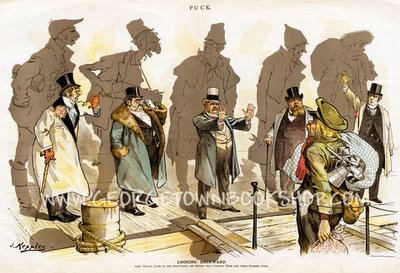 We think of the last five years as a unique time in the
We think of the last five years as a unique time in the The Story of New York House was first published in serial form in Scribner's magazine in 1887. It is a lovely bit of historical fiction (although that term wasn't yet coined), which begins in 1807 and takes place over several decades. The story, or allegory, is about the inexorable march of development followed by decline and finally transformation.
It was written by H.C. Bunner, a prolific urban journalist, fiction writer and editor who lived and worked in
Anyhoo, H.C. Bunner, in addition to being a great humor magazine editor and novelist, was also a serious urban journalist, chronicling life in
"The great city spreads itself day by day ... crawling ceaselessly northward, it divides and subdivides its habitations; gardens disappear and tenement-houses rise; every man’s allowance of space is cut down to its lowest possibility ... And there is still not room. One day, a full block of brown-stone houses, climbing up the rocks by Central Park, cuts right into a gypsy camp of superfluous poor, squatting outside the gates—a peaceable and well-organized colony that could not find room for itself in the regions of brick and mortar."
Bunner clearly spent a lot of time at the “gypsy camp” to write Shantytown, which might have been the first “experiential journalistic” piece to chronicle the life of the poor. It was published in 1880 and Jacob Riis’ How the Other Half Lives, which first appeared as an article for Scribner’s magazine, wasn’t published until 1890. (Interestingly, the Scribner's article was accompanied by illustrations that were drawn from Riis’ photos, even though it would later be his photojournalism of the poor that he became famous for.) What’s more, Bunner’s style in Shantytown and all his other urban chronicles was neither paternalistic nor moralistic, and brings a recognizably modern sensibility to subjects that were either ignored, pathologized or romanticized.
I keep thinking I'm going to undertake a long-term project to resurrect H.C. Bunner as a very talented urban journalist. But until I get to it, for more info on H.C. Bunner, click here. For the entire series of The Story of a New York House, links are below.
The Story of a New York House, Jan. 1887.
The Story of a New York House, Feb. 1887.
The Story of a New York House, Mar. 1887.
The Story of a New York House, Apr. 1887.
The Story of a New York House, May 1887.

